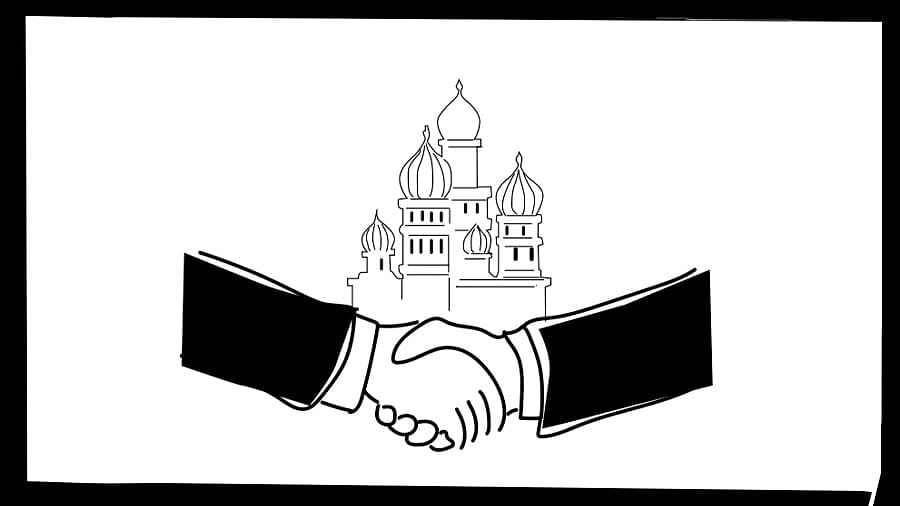
Credit: DH Illustration.
Perhaps around the time Russian President Vladimir Putin welcomes Prime Minister Narendra Modi in Moscow — who is on his first State visit after getting re-elected for the third time as prime minister — two trains carrying a consignment of coal from St Petersburg will use the International North-South Transport Corridor (INSTC). The INSTC is a multimodal transport system comprising of land and sea routes that will cut through Russia, Azerbaijan, and Iran to reach a port in India. This journey is expected to be completed in 25 days, and is shorter than the traditional route through the Suez Canal which would have taken 40-odd days (and cost much more).
This is just a small slice of the increasing partnership between India and Russia that has grown after the Ukraine conflict that began on February 24, 2022. Modi and Putin will be discussing many topics with the resumption of the India-Russia bilateral summit after three years. The last summit took place in 2021 in New Delhi, and since then a lot has changed since the Ukraine conflict.
As a conscious policy, Western Europe is pushing Russia towards Asia compelling its two allies, India and China, to reconfigure their logistics of trade and communication. It is from this standpoint that the INSTC, which was conceived by Russia, Iran, and India, has got a new life. Russia has a big Asian component, but it has been largely uninhabited. A bulk of the Russian population resides on the European side. What we see now is a geographical shift that will also see greater investments in a depopulated part of the country located in the Asian continent, which has been encroached aggressively by China.
The INSTC is being challenged by the recently signed India-Middle East-Europe Economic Corridor (IMEC), which is a sea-land-sea route corridor. It takes cargo from India to Jebel Ali port in the United Arab Emirates, and through the land route takes it to Haifa port in Israel, then Greece, and beyond. This route is premised on the normalisation of ties between Israel and Saudi Arabia, and the resolution of the Palestine issue.
Coincidentally, the war in Gaza began about a month after the corridor was announced at the Delhi G20 Leaders’ Summit. Many wonder whether the corridor had a role to play in the conflagration in Gaza. While the Suez Canal will be severely impacted as the IMEC also is a shorter route to Europe, several gaps in the project have major financial implications before it becomes an assured route to ferry goods from India to Europe.
Recently, however, Israel tested this route and received cargo from India. The reason was to avoid the Houthi attacks on cargo-laden ships going to Israel through the Red Sea. Russia recognises the implications of the IMEC on the INSTC, but is confident that even the Middle East corridor will help in opening land routes of many landlocked countries of Asia.
In recent months, Russia too has used the INSTC route to supply Russian oil to India, which has reached an astronomical 2+ million barrels a day — more than 40% of the total Indian consumption of oil. This is far higher than what India has bought from Saudi Arabia and Iraq. India’s purchase of Russian oil, despite US sanctions, has strengthened ties between the two countries. Experts suggest that Modi skipped the Shanghai Cooperation Organisation (SCO) summit in Kazakhstan as he did not want to meet Chinese President Xi Jinping. Modi will attend the BRICS summit in October 2024, in Kazan, Russia.
Russia’s conflict with Ukraine has seen Moscow recruiting soldiers from Asian countries, and the exact number of Indians who are fighting on behalf of Russia against Ukraine is unknown. Many of them died at the border of Ukraine, and though those who have been recruited claim that they have been duped into fighting, reports emanating from Moscow suggest otherwise.
It is learnt that the Indians who have gone to fight for Russia have been lured with the promise of high salaries (of up to Rs 1.6 lakh) and residency in Russia after they serve their contract. Also, those who agreed to go to Russia were not gnawed by guilt as Russia is perceived as a friendly country where they could continue, in many cases, the martial tradition of their families after India’s defence ministry scrapped long-term recruitment in the Army and instead brought in the short term Agniveer scheme. Many Indian parents, reports from Moscow suggest, got in touch with the recruitment office directly.
Interestingly, though the external affairs ministry has taken into cognisance the plight of Indians in Ukraine, the government has not replied to this issue when AIMIM leader Asaduddin Owaisi raised the matter in the opening session of the 18th Lok Sabha. On July 5, External Affairs Minister S Jaishankar said that he raised the issue with his Russian counterpart on the sidelines of the SCO meet in Kazakhstan. On the same day, Foreign Secretary Vinay Kwatra said that Modi while in Russia will press for the early discharge of Indian nationals from the Russian army.
Another compelling issue is the de-dollarisation of BRICS. This involves member nations discarding the US dollar as a reserve currency and transacting in other currencies. The problem here is that there are not many takers for the Indian Rupee, and Russia seems to be sitting on a large pile of Indian Rupees. India has opened its doors to Russian businesses: for example, the Rosneft-Essar Oil deal in 2018, and more recently, in September 2023, the Indo-Russian joint venture Kinet Railway Solutions for the manufacture of Vande Bharat trains. That said, more projects need to be unveiled from India’s side. During Modi’s Russia visit, a push for more investment in the manufacturing sector is expected, which will help in an uptick of jobs in the country.
(The writer is Editor, Hardnews magazine)